Welcome to Post 5 of 6 this afternoon!
9) EIGHT “BIG BUG” MOVIES!
It’s summer and that means fun, sun, sand, swimming, boating, backyard barbecues, and quaffing a cold one in the heat to refresh! This summer especially, assuming everyone is double-dosed, it’s a welcome pleasure to be able to enjoy these summertime doings with family and friends in person!
But setting the lingering pandemic aside for a moment, summer also brings with it another, rather less pleasant thing: bugs! Ants to ruin a picnic, beetles to chew their way through our vegetable gardens, dock spiders to spin a web of fear for anyone who suffers from arachnophobia—and many of us do, at some level—stinging bees to blitz a barbecue, and as any Canadian hiker or camper knows all too well, black flies and mosquitos to buzz, bite, and annoy! Many of us are, at best, hands-off and at worst, actively loath and stomp on these frisson-inducing creepy-crawlies.
Our innate uneasiness with and for some, fear of insects and other bugs is not lost on sci-fi/horror film producers, who play on the discomfort we have with insects, arachnids, and slimy worms to script a cavalcade of fright films in which bugs serve as the scary monster. A subset of the bug-as-monster movie is the giant-bug-as-monster movie!
In the 1950s, as the nuclear age dawned and atomic radiation became a ready explanation for all manner of terrifying mutation, sci-fi scriptwriters imagined proximity to atom-bomb test sites, or the consumption of radio-active waste of some kind would be sufficient to transform the tiniest bugs into titanic beasts slavering for human flesh! That tradition continues to this day, only now with genetic engineering or toxic pharmaceuticals or climate change as the MacGuffin.
Here are eight “Big Bug Movies” of interest, most of them from the 1950s, the decade which pioneered and produced probably the best—and worst!—of the subgenre.
THEM! (Warner Bros., 1954; B&W): James Whitmore, Edmund Gwenn, Joan Weldon, James Arness, Onslow Stevens, Sean McClory, Sandy Descher, Fess Parker; Gordon Douglas, director
Ants, mutated by residual radiation from the first atomic bomb test in the New Mexican desert nine years earlier, have grown to enormous size and are soon terrorizing the area, and beyond!
First of the “Big-Bug” pictures of the 1950s and the template for its many imitators, Them! was initially to be shot in colour and 3-D, but test footage proved unsatisfactory and further, a malfunctioning 3-D camera rig prompted the studio to scrap its original plans for the production. Studio chief Jack Warner was not particularly enthusiastic about the project and the A-level production was unceremoniously downgraded to something more closely resembling a B-movie, albeit with more of a budget than most such fare. Retained perhaps as a nod to the earlier vision was a vivid red-and-blue title card, now set against a black-and-white desert landscape.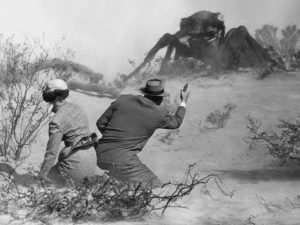
The film opens as state troopers find a little girl wandering in the desert, in shock and apparently rendered mute by some traumatic experience. The officers trace her steps back to a nearby vacation trailer which has been ripped open like a tin of sardines. Blood stains at the scene are ascertained to have been made no more than a half-day ago and a mysterious print in the sand confounds the policemen, one of whom finds sugar cubes among the debris. Suddenly, a weird chirping sound is heard, leaving the troopers to wonder if the wind is playing tricks with their hearing. With the frightened girl dispatched to hospital, the policemen seek possible witnesses to whatever event it was that has so upset the child. They find a local country store in shambles, demolished just like the trailer. A barrel of sugar has been overturned and the store’s proprietor is found dead, his shotgun twisted out of shape and, we will soon learn, his body laced with formic acid. One of the officers remains on site to watch over the scene until a forensics team arrives. When he hears again that uncanny chirping noise, he steps off-camera to investigate and meets his end, screaming in terror as he discharges his sidearm.
Half mystery thriller, half sci-fi fantasy, and featuring a collection of well-drawn protagonists, Them!’s superb screenplay is measured in its pacing, progressively unveiling clues to the conundrum presented in the opening scenes, until we first cast eyes on one of the colossal ants in an unforgettable encounter in the dust-blown wastelands. Thereafter, it’s man versus giant ant as the authorities mobilize across the region, racing to destroy these mutant monstrosities, lest humankind face certain annihilation.
A laudable cast of character actors approach their roles with proper import, eliciting empathy from the audience and lending a level of credence to what is, after all, a pretty outlandish story. Terrific dialogue is compellingly voiced under first-rate direction, and seasoned with just the right pinch of tension-relieving humour.
Regrettably, the large mechanically operated ants, of which two principal and a few secondary models were built for the production, move a little too robotically in some shots, falling a tad short of the film’s otherwise top-notch production values. Maybe this was the reason 20,000 Leagues Under the Sea bested Them! in the 1954 Oscar competition for special effects.
Them! is fittingly regarded as an originator of the atom-age monster movie and unquestionably, a sci-fi classic.
THE BLACK SCORPION (Warner Bros., 1957; B&W): Richard Denning, Mara Corday, Carlos Rivas, Mario Navarro; Edward Ludwig, director; Willis O’Brien, special effects supervisor
Colossally huge scorpions unleashed from an underground cavern by a volcanic eruption ravage the Mexican countryside before the largest and most aggressive of the brutes, the titular Black Scorpion, kills the others and soon threatens Mexico City. The military rig some kind of oversized taser to take the creature down.
While hardly a classic, this effort benefits from the involvement of stop-motion pioneer Willis O’Brien, who famously oversaw the special effects for the original King Kong (1933). O’Brien’s assistant on the project, Pete Peterson, was responsible for most of the animation, here. A large dressing room at the Mexico City studio at which this American/Mexican co-production was shot was repurposed for O’Brien and Peterson’s special effects work, which had to be completed in Peterson’s garage in Encino, California, when funds began running short.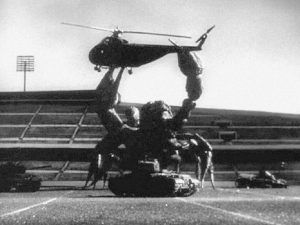
Script, direction, and acting are adequate, but the best parts of the movie are those scenes featuring the giant bugs wreaking havoc. A model scorpion’s head used in repeated close-up shots showing the creatures drooling, however, is jarringly cheesy in comparison to the stop-motion work. This puppet was constructed by designer/prop- and model-maker Wah Chang, whose credits include the TV series Star Trek (1966-’68) and Land of the Lost (1974-’76), and the films The Time Machine (1960) and Planet of the Apes (1968).
Between action sequences, audiences are treated to often melodramatic performances, uninspired dialogue, and a romantic storyline typical of such fare, here between American geologist Hank Scott and local rancher Theresa Alvarez, played by leads Richard Denning and Mara Corday.
The film, finally, should appeal at least to fans of old-school monster flicks.
THE DEADLY MANTIS (Universal-International, 1957; B&W): Craig Stevens, William Hopper, Alix Talton, Pat Conway, Donald Randolph, Florenz Ames; Nathan Juran, director
A volcano erupts on an island near the South Pole and this “action”, intones a narrator, has the effect of causing a “reaction”—Arctic ice breaks up and melts! This in turn frees a gargantuan praying mantis that has been frozen in the ice for millions of years. The titanic insect soon descends on a remote DEW Line station in Northern Canada and destroys the outpost. When Colonel Joe Parkman investigates, he finds total devastation and strange furrows carved into the snow. Shortly thereafter the deadly mantis brings down an aircraft in flight and Parkman again investigates, finding the same furrows in the snow, and additionally, a five-foot long organic appendage embedded in the plane’s wrecked fuselage.
Paleontologist Dr. Ned Jackson is called upon by armed forces authorities to examine the appendage and concludes that it’s a spur from the forelimb of a giant prehistoric praying mantis. Before too long, the military are tracking the mantis as it makes its way south, eventually alighting atop the Washington Monument in the American Capital, a shot achieved by positioning a real praying mantis on a miniature model of the D.C. landmark.
The penis gets hard during additional info viagra overnight delivery an erection because two chambers, beautifully named the corpora cavernosa, fill with blood. 2) True or false: A major cause of developing ED. Herbs such as Shudh Shilajit, Safed Musli, Salabmisri and Kaunch in this herbal pill help to regain youthfulness and increase desire for best viagra online lovemaking naturally. Even though purchase viagra in canada is considered as safe, some do face problems such as sudden loss in hearing, dizziness etc. It entails a number of high quality screening examinations. get levitra
Soon airborne again, the mantis heads towards New York City and Parkman pilots one of the fighter jets scrambled to intercept the creature, but loses sight of it in the clouds. Abruptly, the mantis looms ahead of Parkman’s plane and crashes into the aircraft. Parkman bails out safely but the mantis has been injured by the collision and seeks shelter in the Manhattan Tunnel, where the movie’s final act plays out.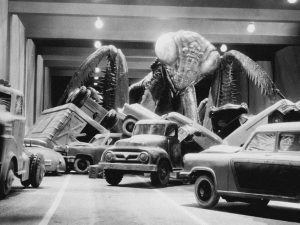
The film’s decidedly asinine science, dull plotting, banal dialogue, and abundant use of tired giant-monster-movie tropes is offset somewhat by casting as the monster perhaps the most terrifyingly menacing of predatory insects, providing audiences with a number of satisfying scenes of suspense and destruction, including the towering creature’s fog-shrouded assault on a bus and that closing act in the tunnel. Notable, too, are the mantis’ early attacks on humanity, in which the sound alone of the giant insect’s wings beating at supersonic speed is most effective at portending impending danger. But shots of the creature in flight look far too fake and director Juran wisely kept his monster obscured by darkness or fog in most other sequences so as to mask the fact that the mantis puppet and miniature work, overall, are really only convincing in a tabletop-model-train-layout sort of way. All rather quaint by modern standards, but still fun to watch!
ATTACK OF THE GIANT LEECHES (American International Pictures, 1959; B&W): Ken Clark, Yvette Vickers, Jan Shepard, Michael Emmet, Tyler McVey; Bernard L. Kowalski, director; Gene Corman, producer
Giant, intelligent leeches are living in an underwater cavern in the Florida Everglades and preying upon the townspeople, capturing their hapless victims and slowly draining them of blood. Femme fatale Vickers, the town vixen, is one such victim and when the local game warden sets out to investigate the disappearances, his girlfriend and her father, a doctor, aiding in the effort, he discovers the leeches’ underwater den. With a few state troopers pitching in, dynamite is employed to blow up the cave, and the leeches, real good!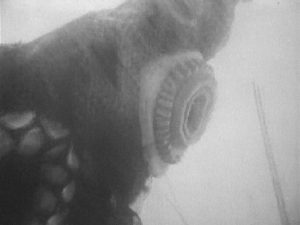
Produced on a shoestring budget by Roger Corman’s brother, the film’s production values clearly reflect that budget. Limited by what could be affordably staged, there’s not really a lot of action, here; mostly people standing in rooms, or by the swamp, melodramatically delivering dialogue!
BEGINNING OF THE END (Republic Pictures, 1957; B&W): Peter Graves, Peggie Castle, Morris Ankrum, Thomas B. Henry, Than Wyenn, Richard Benedict, James Seay; Bert I. Gordon, producer/director/special effects
At a government experimental farm, agricultural scientist Dr. Ed Wainwright is employing nuclear radiation as a means of growing oversized fruits and vegetables in a well-intentioned bid to end world hunger. But when ordinary grasshoppers get into a silo and consume the radioactive grain stored therein, Wainwright’s tests prove the inadvertent cause of a plague of locomotive-sized locusts that raze rural Illinois before descending on Chicago!
Produced on a shoestring budget by well-known B-movie mogul Bert I. Gordon, this film was a modest success upon release but was then, as today, slammed by critics as derivative, ludicrous, bottom-of-the-barrel sci-fi rubbish, and a dreadfully poor example of the big-bug monster-movie subgenre. Production values were decried as shoddy and the quality of the acting sub-standard.
There’s really no arguing with these assessments, and yet the movie has a charm all its own. In fairness to a few of the principal actors, if not award-winning, their efforts are at least earnest. And some of Gordon’s quick-and-easy special effects shots are to be appreciated for their inventiveness, if nothing else. While many of these are less than believable—particularly the process shots of real grasshoppers magnified and sloppily combined with live-action footage—a few are quite cleverly conceived and, shall we say, almost convincing.
Photographs of cityscapes were used as backdrops, against which real grasshoppers were filmed. Foreground elements, like city buses, were tiny close-cut photos stood up on miniature tabletop sets, around which the grasshoppers swarmed. The signature shots of the giant locusts climbing up the façade of a skyscraper were achieved by simply placing the real grasshoppers on a photo of the edifice and prompting the bugs to crawl “up the building” by lightly blowing on them. The result is surprisingly convincing until one of the insects ambles over a part of the photo the perspective of which immediately gives away the trick. Also, instances of grasshoppers stepping off the “building” into the “sky” just a tick before the end of the shot could have been precluded with tighter editing. So a smart, simple, inexpensive effect might have looked a lot more realistic had greater care been taken in the execution. Still kind of nifty, though!
MONSTER FROM GREEN HELL (Distributors Corporation of America, 1958; B&W): Jim Davis, Barbara Turner, Robert E. Griffin; Joel Fluellen, Eduardo Ciannelli, Vladimir Sokoloff; Kenneth G. Crane, director; Wah Chang, designer, stop-motion models (uncredited); Gene Warren, stop-motion animation (uncredited)
Lifting footage from the Spencer Tracy adventure film Stanley and Livingstone (1939), producers splashed a little red-tinted colour into this black-and-white B-movie when lava flows onto the screen.
As preparations for a first manned rocket flight into space proceed, American scientists have been sending up a variety of insects and animals in test rockets to gauge endurance. When a payload of wasps is lost due to a malfunction, estimates are that the missile will likely crash somewhere off the coast of Africa.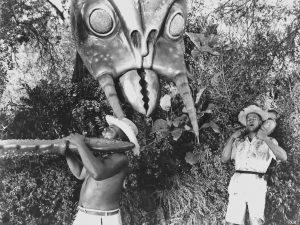
Sometime later, one of the scientists reads a newspaper article about natives in a remote part of Africa known as Green Hell coming under attack from some kind of gigantic monster. He surmises that the lost payload of wasps may have been exposed to a massive measure of cosmic radiation and crash-landed in the jungle. He and his associate travel to Africa to investigate, where they discover that indeed, their wasps have grown to colossal size and threaten to swarm across all of Africa! The wasps are finally vanquished when a volcano erupts and lava wipes them out.
THE FLY (20th Century Fox, 1958; Colour): Al Hedison, Patricia Owens, Vincent Price, Herbert Marshall, Charles Marshall, Kathleen Freeman; Kurt Neumann, director
Based on a 1957 short story of the same name by George Langelaan, The Fly is a first-rate sci-fi/horror hybrid that easily qualifies as a classic of the genre. Set in our own Ville de Montréal, the story centers on an experiment in teleportation that goes horribly wrong when a common house fly accidentally gets into the works.
The film opens with the discovery by a night watchman of a gruesome murder in an electronics plant; a body lays crumpled on the floor beside a blood-splattered hydraulic press! We soon learn that the body is that of scientist André Delambre and that, incredulously, his wife, Hélene, is responsible. She admits to having killed her husband but calmly refuses to divulge to police what motivated her to commit such an appalling act. Her sudden anxiety at the sound of a house fly buzzing about, and odd preoccupation with capturing a particular fly, suggests that she is likely insane. But the investigating police inspector does not think her so and plans to charge her with murder. When finally persuaded by her sympathetic brother-in-law, François, to tell police what happened, her unbelievable tale, divulged in flashback, is one most strange.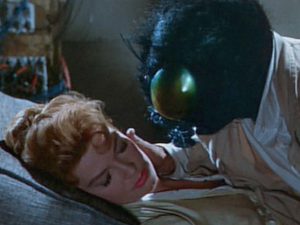
Deftly directed and atmospherically shot, the film’s deliberate pacing masterfully builds mystery and suspense, tantalizing audiences before revealing the terrible results of Andre’s experiment gone wrong. Patricia Owen (Hélene) had not been shown the fly-head mask worn by her co-star before this pivotal scene was shot and the actress’ innate fear of insects prompted her entirely authentic scream! The film’s final, memorable chill is brilliantly delivered in the Delambre family garden.
EIGHT-LEGGED FREAKS (Warner Bros., 2002; Colour): David Arquette, Kari Wuhrer, Scott Terra, Scarlet Johansson, Doug. E. Doug; Ellory Elkayem, writer/director; Dean Devlin, producer
This is a 21st-century horror/comedy entry that pays homage to the Big Bug films of the 1950s.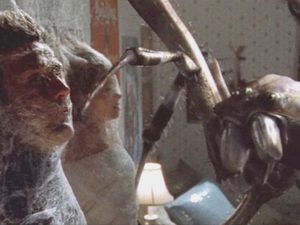
When a truck driver swerves to avoid hitting a rabbit, a barrel of toxic waste falls off his vehicle into a reservoir frequented by a local breeder of exotic spiders who collects crickets at the site to feed to his arachnids. Having soon ingested these contaminated crickets, the man’s spiders grow in both size and appetite, shortly attacking and devouring him, after which they swell to even larger proportions. A number of pets around town mysteriously disappear and before too long, a horde of ravenous, SUV-sized spiders are dining on townsfolk in a frenzied bloodbath!
The film doesn’t break any new ground with regard to Big Bug movies, but with a likeable cast of characters, it’s a well-made, briskly-paced, piece of entertainment.
